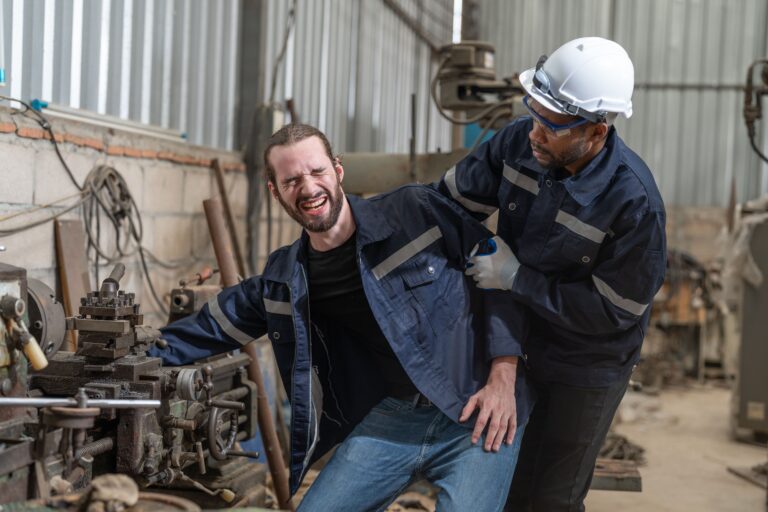
Crush Injuries at Work
Crush injuries occur when an excessive compressive force is applied to a body part that is caught or stuck between two objects. These injuries are more likely to occur in industrial settings that involve the use of heavy machinery. They could also happen on construction sites, warehouses, and in large or small employment establishments. A factory worker whose hand is caught in a machine, a forklift falling on a person’s leg or arm, or even a finger jammed in a closing door are all examples of crush injuries.
These types of injuries may lead to significant pain and trauma and sometimes are life-changing events affecting both an injured worker and their family.
Common Crush Injuries
The severity of a crush injury depends on the force’s duration, magnitude, and surface area involved. Immediate short-term damage to the tissue during a crush injury results in acute symptoms. These might include:
- Bruises that result from compressed small blood vessels.
- Skin lacerations, which can cause excessive bleeding and lead to infections.
- Bone fractures caused by a crushing force. In a crush injury, bones are more likely to shatter into smaller pieces rather than a single break. In more severe cases, the fragments of bone can tear into soft tissue and sever the skin.
- Nerve damage that can cause pain, numbness and tingling, and weakness. In some cases, it may lead to paralysis.
The long-term effects of crush injuries come from complications after the initial trauma. They persist after the acute stage passes. Some of these may include:
- Compartment syndrome caused by prolonged compression. This is a common complication of a crush injury. Inflammation and swelling may lead to pressure on the muscles and nerves within a limited space. This happens because fluids accumulate faster in an enclosed space than they can dissipate to other parts of the body. If not treated, compression can cause damage to the nearby muscles and nerves.
- Scar tissue that forms when the body heals from a wound or surgery. This is the body’s natural response to damage, but scar composition is different from skin and muscle tissue. It is made of collagen, which is less elastic than normal tissue. In some cases, people experience scar tissue pain because the body produces an excessive amount of collagen. Scar tissue causes pain because of tightness and limited range of motion.
- Post-traumatic stress disorder may develop in people who have experienced a traumatic event. Re-experiencing the trauma, flashbacks, or bad dreams may cause problems in one’s everyday life and may slow physical recovery.
How Crush Injuries Happen
Workers in fields, offices, and industrial settings are all at risk for crush injuries. OSHA estimates that over 125,000 workers suffer crush injuries each year. Crush injuries may happen because of faulty equipment, but most accidents occur when safety standards are not followed. Often, these injuries occur when workers get distracted. Possible causes of crush injury include:
- Lack of appropriate training in specific tasks, tools, and equipment.
- Insufficient planning when deciding on necessary steps for work safely.
- Inappropriate attire, including sleeves that are too long or loose, and can be pulled into moving parts of a machine.
- Vehicles, powered doors, and forklifts that have not been properly tagged out, blocked, or stowed.
- Placing fingers or toes in the way of doors, file drawers, and heavy crates.
- Failure to follow the safety guidelines.
- Equipment failure or mistakes committed by other parties.
Steps to Prevent Crush Injuries
Taking simple precautions and learning the specific hazards of your tasks, tools, and equipment will help to avoid many crush injuries:
- Read and follow warning signs posted on equipment.
- Give your work full attention, and try not to multitask.
- Maintain your equipment in proper order and report any malfunctions to your employer.
- Use barriers like tool guards usually provided with your machinery.
- Dress appropriately, and avoid wearing loose or dangling jewelry.
We’re Here for You
Physical and Occupational Therapists at Ivy rehab are experts in treating injuries from crush injuries. We do not use a cookie-cutter approach. Each patient is individually evaluated, and a specific plan is tailored to their unique needs. We work closely with the other members of the clinical team to complement medical and surgical care to achieve maximum functional outcomes.
We are committed not only to guiding injured workers who have sustained a crush injury in their physical recovery, but we also understand their emotional state. Ivy Rehab experts are dedicated to seeing a patient through to their full recovery. Click here to find a location near you.
Article By: Boris Gilzon, PT, DPT, OCS, CHT
Boris Gilzon began his career 34 years ago. Boris loves working with the hand injured population and believes in the importance of improving their daily function. He currently specializes in Hand Injuries. Boris enjoys working with post-surgical and trauma cases to reach their full functional potential.
The medical information contained herein is provided as an information resource only, and does not substitute professional medical advice or consultation with healthcare professionals. This information is not intended to be patient education, does not create any patient-provider relationship, and should not be used as a substitute for professional diagnosis, treatment or medical advice. Please consult with your healthcare provider before making any healthcare decisions or for guidance about a specific medical condition. If you think you have a medical emergency, call your doctor or 911 immediately. IvyRehab Network, Inc. disclaims any and all responsibility, and shall have no liability, for any damages, loss, injury or liability whatsoever suffered as a result of your reliance on the information contained herein.